Medicines

Where do medicines fit in?
ALSO AVAILABLE AS A PRINTED BOOKLET Informative booklet that will support you in reviewing pain medicines with a person with pain. It describes:
- Why persistent pain happens
- How pain medicines can be helpful as part of your pain management plan
- Some common problems you may experience with these medicines
- When to consider reducing your pain medicines and how to do it
- Other ways of living well with pain
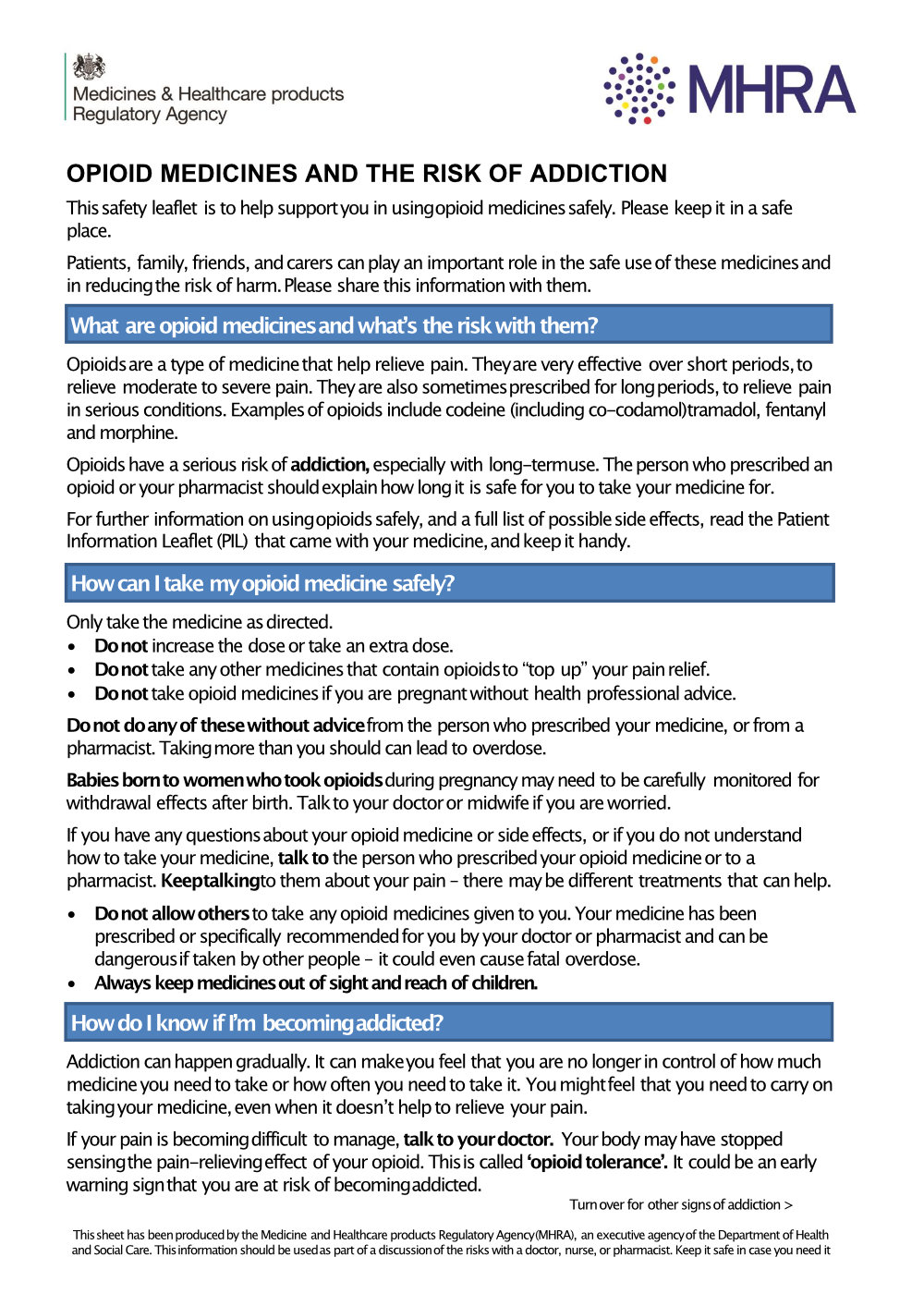
Opioids and the risk of addiction
Produced by the Medicine and Healthcare products Regulatory Agency (MHRA), an executive agency of the Department of Health and Social Care. It should be used as part of a discussion of the risks with a patients, who should be encouraged to share it with family, friends or carers, as they can all play an important role in the safe use of these medicines and in reducing the risk of harm.
Download the leafletSomerset CCG Pain Management site
Newly developed website from Somerset, which includes lots of resources aimed at improving knowledge for practitioners, practise resources and examples for supporting tapering.
Somerset CCG Pain Management siteResources for GPs on opioids and chronic pain
Although patients are now unlikely to be started on opioids for chronic pain, there is a large group of patients who have been established on long-term opioids, but who may struggle to reduce and stop their opioids. These patients are unlikely to be deriving any benefit from the opioids but are exposed to significant harm, with some on extremely high doses. Oxford University Hospitals NHS Foundation Trust has put together useful guidance for GPs to help manage these patients together with an opioid calculator.
Resources for GPs on opioids and chronic painOpioids Aware
Information from Opioids Aware to support a safe and effective prescribing decision.
Good practice in prescribing opioid medicines for pain should reflect fundamental principles in prescribing generally. The decision to prescribe is underpinned by applying best professional practice; understanding the condition, the patient and their context and understanding the clinical use of the drug. Initiating, tapering or stopping opioid medicines should be managed in agreement with the patient and all members of their healthcare team. This resource, developed by UK healthcare professionals and policymakers, provides the information to support a safe and effective prescribing decision. Developed by The Royal College of Anaesthetists Faculty of Pain Medicine, 2017 Opioids AwareOpioid medicines and the risk of addiction
Safety leaflet to help support patients in using opioid medicines safely. Produced by the Medicines and healthcare products Regulatory Agency
Opioid medicines and the risk of addiction
Patient stories: the harms of opioid prescribing
Guidance from NICE is clear that opioids are not indicated for chronic pain, and guidance from the Royal College of Anaesthetists (the professional body for doctors that specialise in pain) has been clear about the harm that can be caused. NHS England has produced two videos that illustrate the harms of strong opioid prescribing in chronic pain:
Faye’s story
Faye’s story puts these potential dangers into reality by describing, from her parents' perspective, the sequence of events that ultimately led to her untimely death from respiratory depression.Sean’s story
Sean’s story describes how strong opioid prescribing had a devastating impact on his quality of life, and how he has engaged with more effective non-drug therapy that has been life-changing. Patient stories: the harms of opioid prescribingOpioid Tapering
Information for patients. Developed by National Pain Centre, McMaster University, Canada, 2017
Download
The Great Opioid Side Effect Lottery
Often, patients being prescribed opioids for their persistent pain do not know how little benefit they offer over the long term, or how prevalent and varied are the side effects people experience. This A4 sheet, designed to be used by clinicians in their consultations with patients, is a simple way to raise the question of benefits versus side effects. Using a ‘lottery scratch card’ metaphor, the sheet explains that opioids only actually reduce pain for around 10% of people in the long term, and their side effects can be both wide ranging and serious. It lists many of the side effects, and provides a number of statistics to show how common these side effects are. Working through the list with your patient, ask them to tick those side effects they are experiencing, as a starting point for introducing the idea of a medicines review.
Download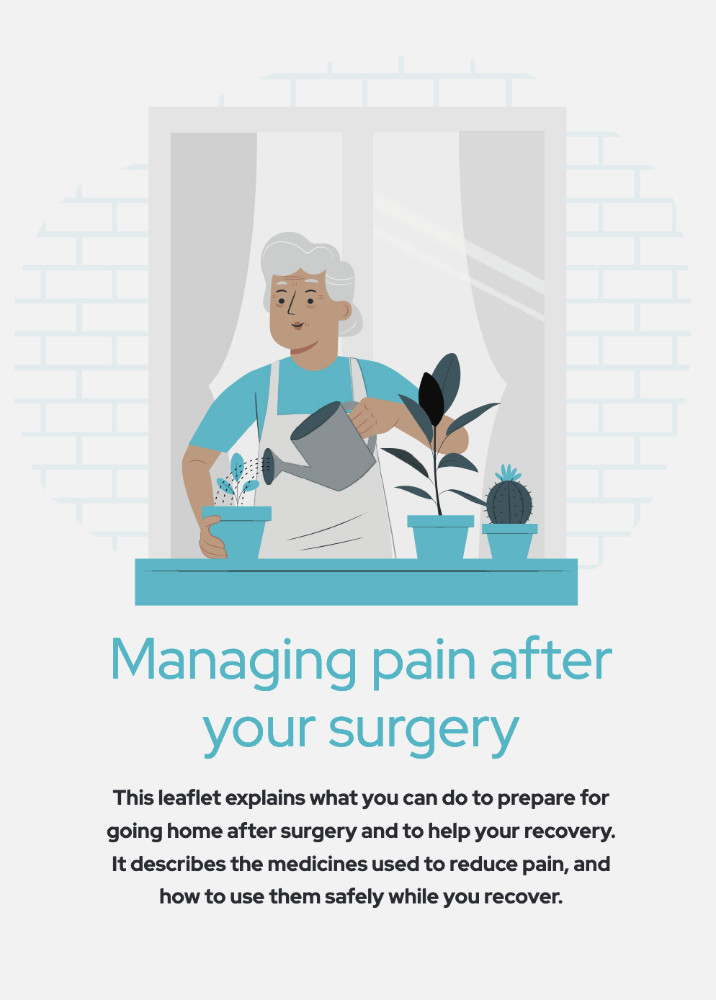
Pain management after surgery
A widely endorsed leaflet developed by the British Pain Society and its partners. Includes a useful timeline to be completed by the clinical team, showing the patient how soon they need to taper and stop medicines in order to avoid possible dependency.
DownloadOpioids and Driving
Information for patients from Opioids Aware. Developed by The Royal College of Anaesthetists Faculty of Pain Medicine, 2016
DownloadTaking Opioids for Pain
A patient information leaflet from Opioids Aware. Developed by The Royal College of Anaesthetists Faculty of Pain Medicine, 2016
DownloadTen Opioid Safety Messages
A patient information leaflet. Developed by West Suffolk Community Pain Management Service, 2016
DownloadPerson Centred Management of Chronic Non Cancer Pain
A tool designed to help family physicians and nurse practitioners develop and implement a management plan for adult patients with Chronic Non Cancer Pain in the primary care setting. With clear information on non-pharmacological treatments, non-opioid medications and opioids prescribing. Developed by Centre for Effective Practice, Canada, 2017
Download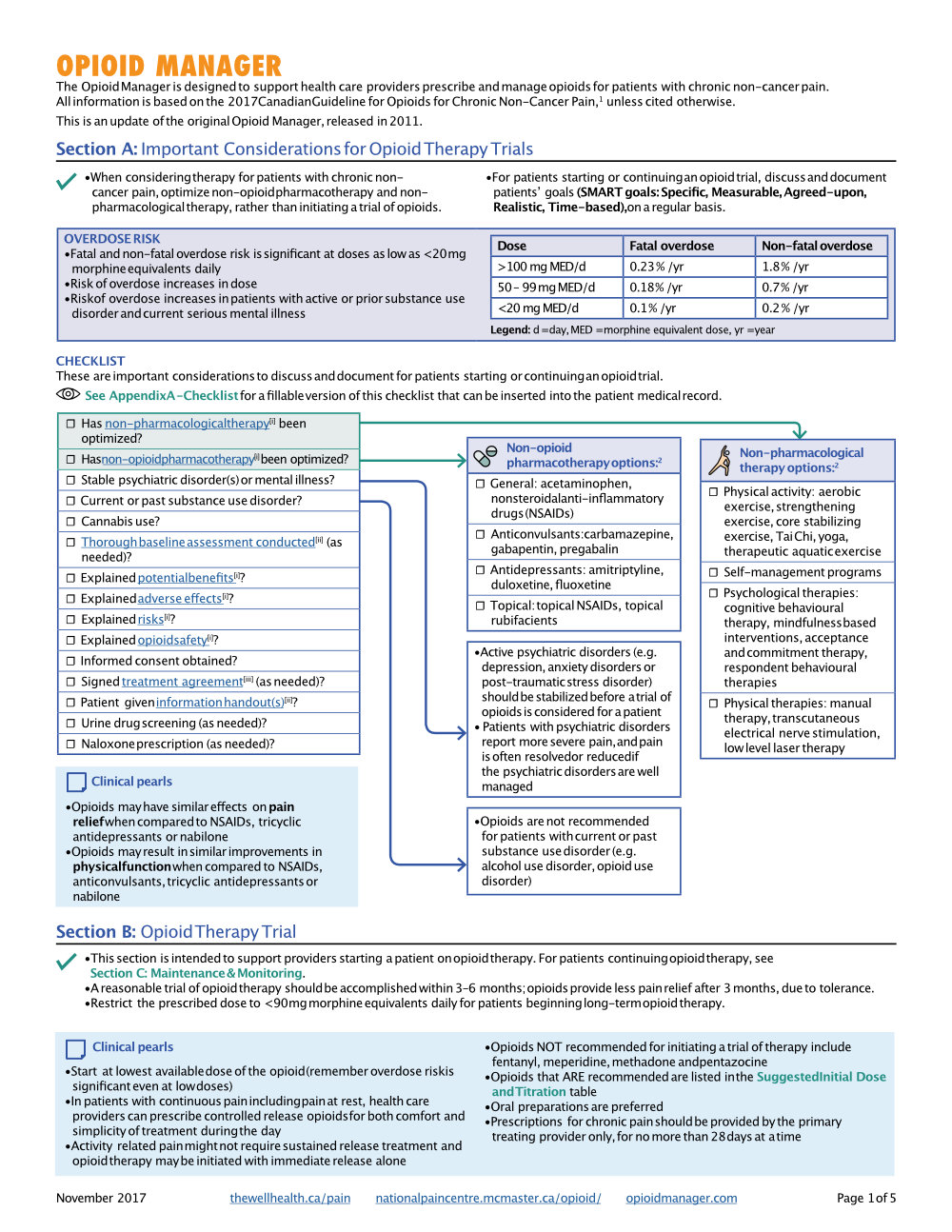
Opioid Manager
These charts for clinicians to support effective, safe prescribing and management of opioids for people with chronic non-cancer pain. Developed by National Pain Centre, McMaster University, Canada, 2017
Download the charts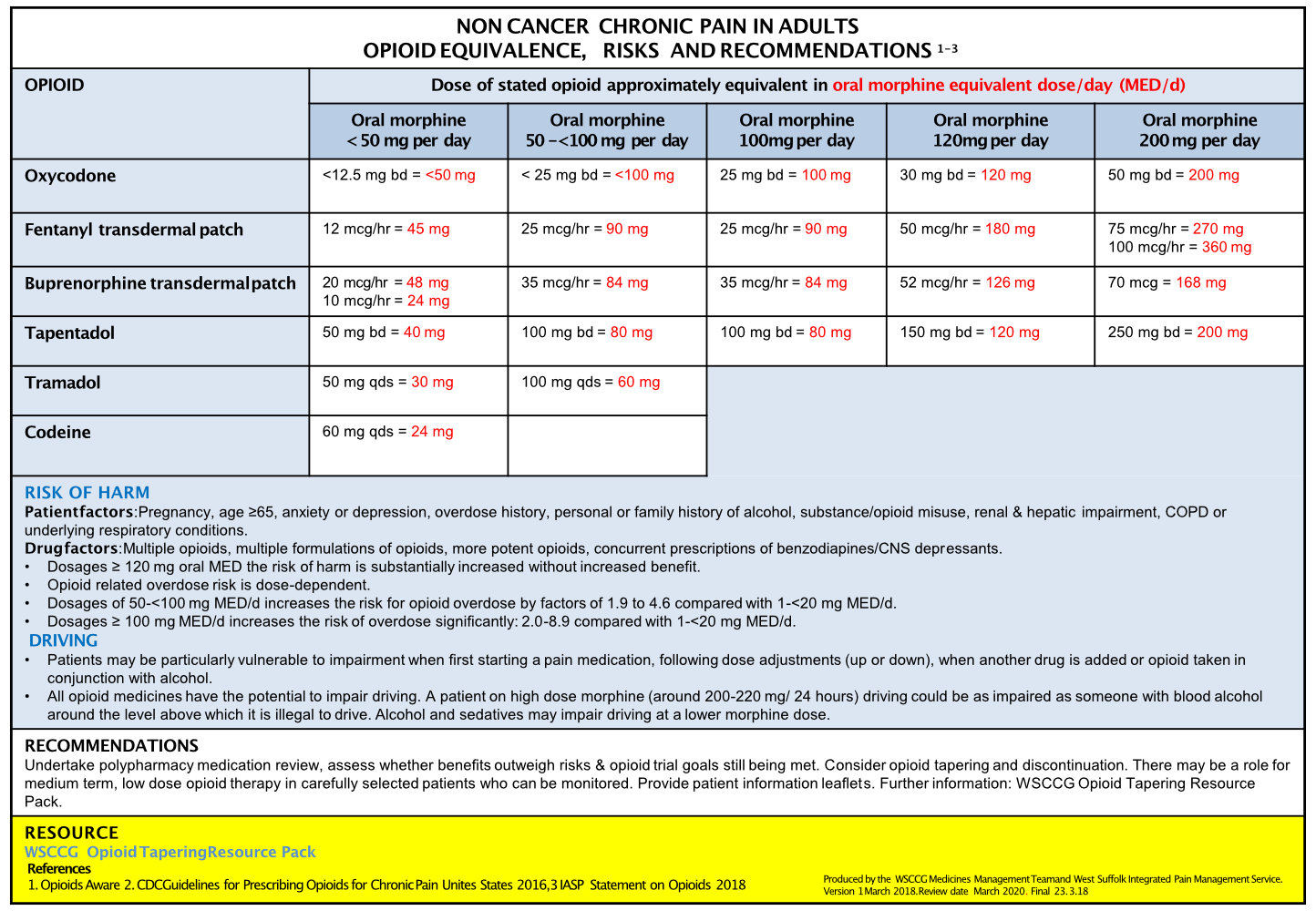
Opioid equivalence, risks and recommendations
How much opioid is the person taking? A valuable guide to dosing based on oral morphine equivalent dose/day to enable safe prescribing. Developed by WSCCG Medicines Management Team and West Suffolk Integrated Pain Management Service, 2018
Download the guidePain and pain prescribing: what is in a number?
Live Well with Pain is very pleased to be hosting this key paper by Cathy Stannard, the UK’s leading pain medicine specialist, from Gloucester CCG, published in the British Journal of Anaesthesia.
Download
An opioid thermometer
How much opioid is a person taking? The opioid thermometer helps to estimate dosing based on oral morphine equivalent dose, and can be used to guide safer prescribing. The PDF contains two versions: the first goes up to 120mg morphine per day, the second to 250mg morphine per day.
Download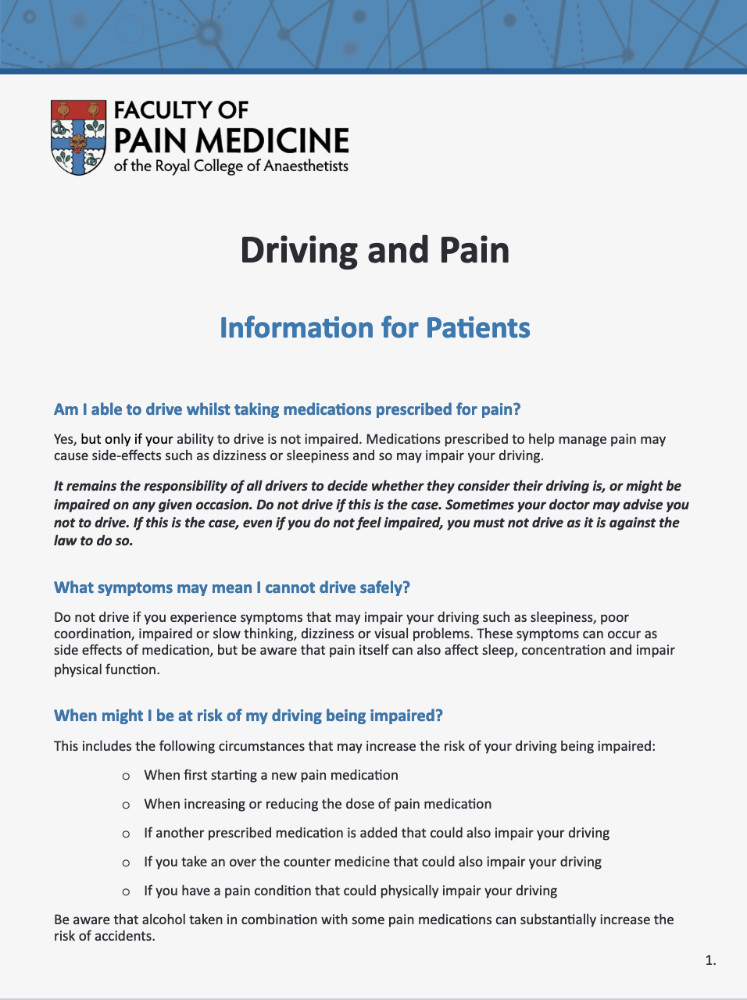
Driving and Pain
Information for patients on driving whilst taking medications prescribed for pain.
Download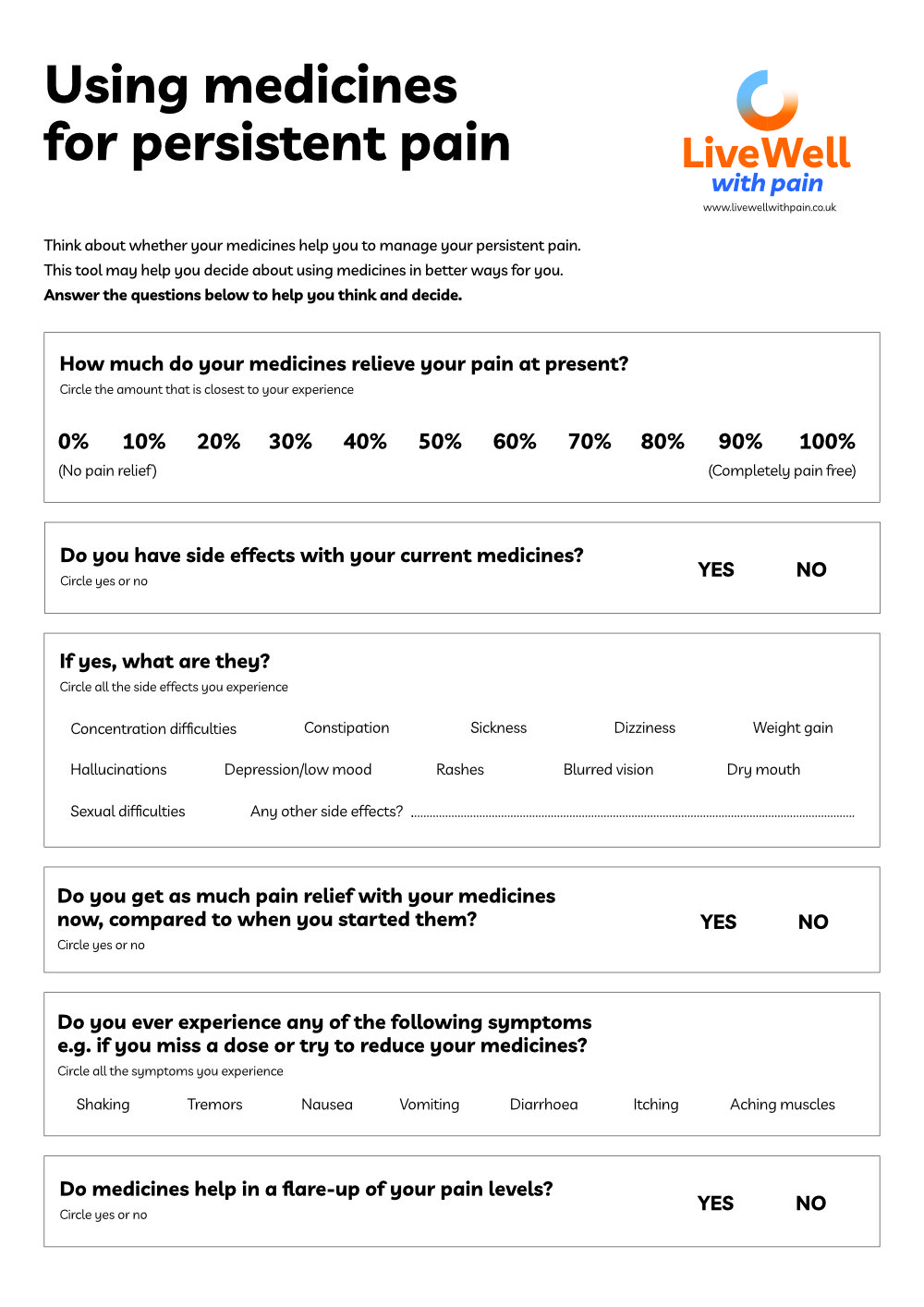
Medicines Decision Guide
Is your patient wondering whether the pain medicines they take are really helping? Completing this guide and sharing it with you can help them understand why they may be thinking about continuing, reducing or stopping their pain medicines.
Download